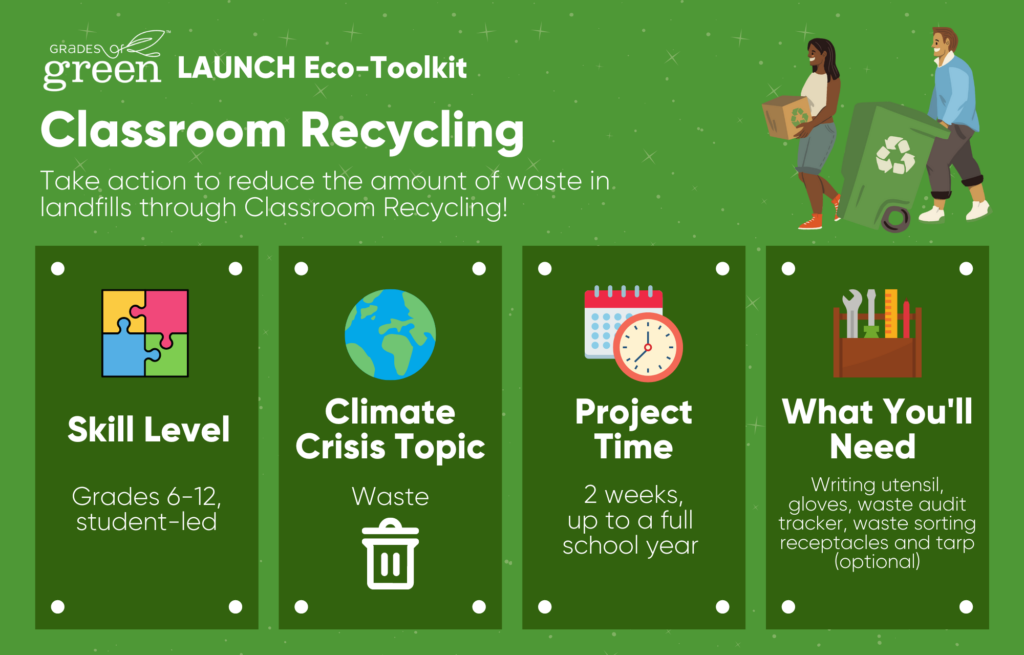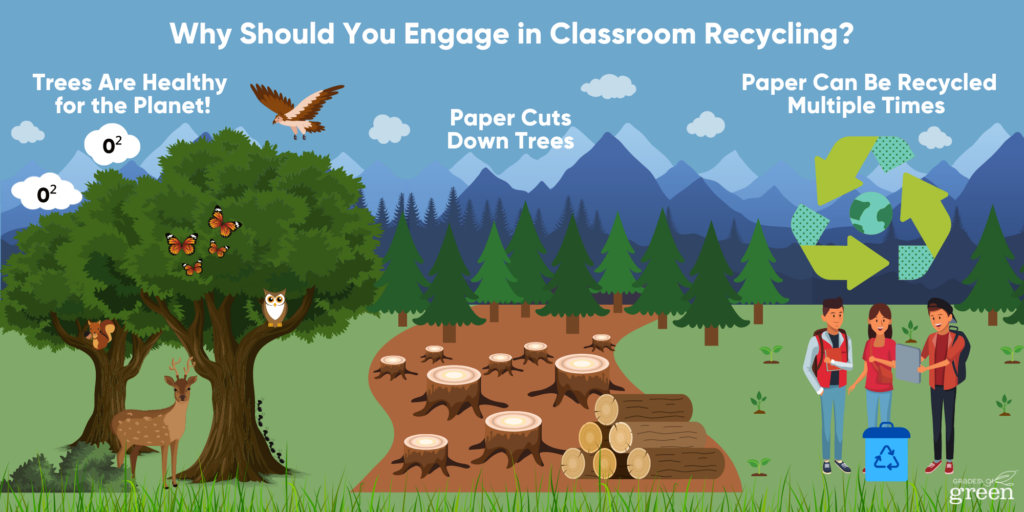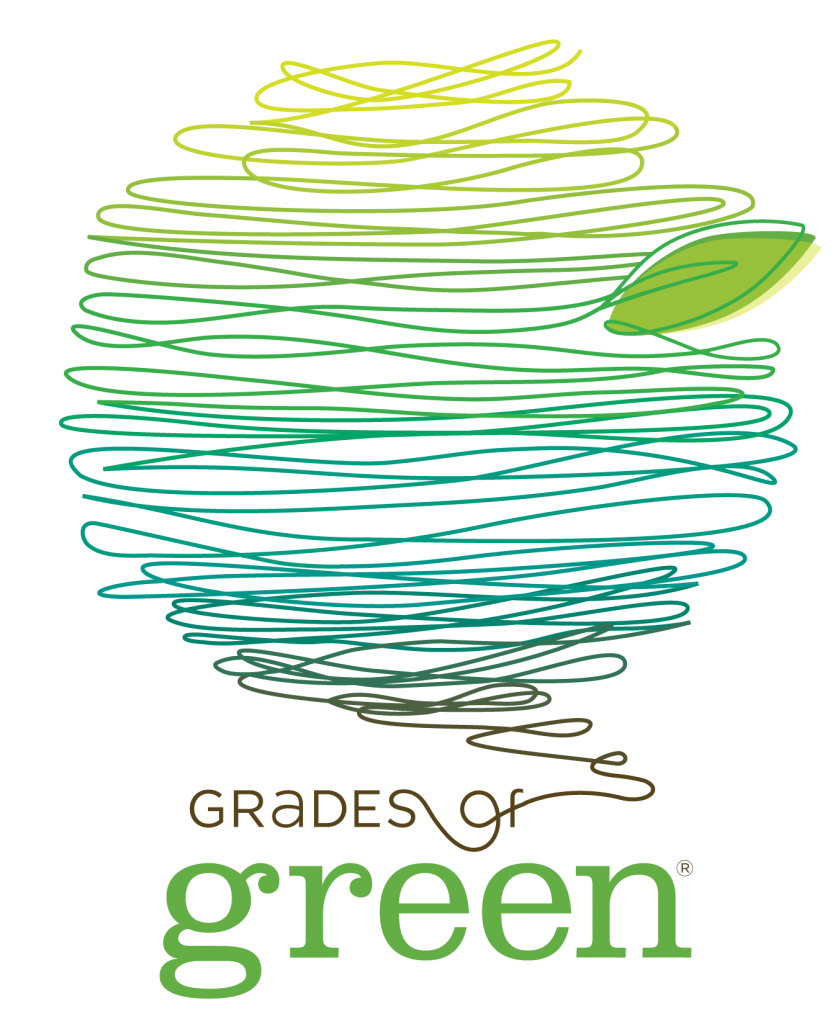Love trees? Set up paper recycling in your classroom!
Have you ever looked through your classroom trash can? What do you see? Chances are it’s made up of mostly paper which can be easily recycled into new paper products! Recycling in your classroom is one of the easiest things you can do at school to reduce your campus waste.

Toolkit Details


NGSS
This toolkit address the following Science and Engineering Practices (SEPs) within the Performance Expectations of NGSS for Grades: 6-8 and 9-12
- Asking Questions and Defining a Problem
- Planning and Carrying out Investigations
- Analyzing and Interpreting Data
- Using Mathematics and Computational Thinking
- Constructing Explanations and Designing Solutions
- Obtaining Evaluating, and Communicating Information
Learning Objectives
- Analysis
- Students will analyze their classroom waste to determine which items can be recycled
- Project Management
- Students will set goals to determine how much waste they will divert from landfills.
- Students will identify routines to accomplish their goals.
- Students will practice leadership by educating each other on correct recycling
- Evaluation and Assessment
- Students will track and evaluate the impact of their project
Why It’s Important?
Our landfills are filling up at an alarming rate with resources such as paper that can be recycled or upcycled to be used again. In order to reduce the amount of waste in landfills, it is important to sort out recyclables to get them to the right place. This reduces the amount of trash in the environment and allows us to reuse valuable resources.
What You Will Accomplish
Students will take action by recycling their classroom waste.
Why Should You Set Classroom Recycling?
The resources provided can be shown as a slideshow or printed out as individual worksheets for students to learn.

Trees Are Healthy for the Environment!
Trees provide many benefits to the health of both people and the planet. They provide shade, cool neighborhoods, they create habitats for birds/wildlife, and prevent soil erosion. As trees grow, they help slow down climate change by removing carbon dioxide from the air, storing carbon, and releasing oxygen into the atmosphere. [1]
Paper Cuts Down Trees
Paper making has an impact on the environment because it destroys trees in the process. According to data from the Global Forest Resource Assessment, roughly 80,000 to 160,000 trees are cut down each day around the world with a large portion of that being used to make paper. This contributes to global deforestation which in turn is a big cause of global warming and climate change.[2]
Paper Can Be Recycled Multiple Times
Recycling paper is very important in reducing the environmental impact of paper manufacturing. Paper can be recycled about 5 to 7 times before the fibers become too short to be reused and using one ton of recycled paper can prevent 17 trees from being cut down. [2]
Waste is an Environmental Justice Issue
Waste is often classified as an environmental justice issue due to the inequities that exist between different communities. Wealthy neighborhoods are often given more resources to manage waste while disenfranchised communities are frequently left with inefficient provisions to maintain a clean living environment. Furthermore, the same communities with lower incomes are usually placed in close proximity to waste management facilities where additional pollution burdens individuals.
Watch these two short videos to learn why it’s important to recycle in your classroom!
Think About It!
Pre-Activity Questions
- What are the most common types of waste you see in your classroom trash bin?
- What types of products do you think paper waste can be recycled into?
- What are some ways to conserve paper other than recycling?
- Why is sorting and recycling waste important for the environment?
Take Action: How to LAUNCH Classroom Recycling
Follow the steps below to set up a successful Energy Audit at your school! Need help? Contact us!
Step 1: Get Organized
- Use the Classroom Recycling Sign Up Sheet to invite class members to participate.
- Choose 1-3 students to empty the bin weekly (or as needed) into a larger recycling dumpster or bin on campus.
If your classroom has rotating classroom jobs, add this to the list of responsibilities.
Step 2: Conduct a Pre-Audit
To understand how waste is managed at your school, it is important to conduct a pre-audit; this can be completed using the Classroom Recycling Audit Worksheet. Keep note of what you analyze and compare them with your final statistics at the end of the campaign.
Step 3: Identify a Location
Consult with your campus custodial team to determine where campus recycle containers are kept on campus. This may be a large dumpster or rolling recycle carts. Consult with the custodial team to determine the best way for students to empty classroom recycling into these containers.
Step 4: Prepare Your Materials
There are many options to obtain a recycling bin in your classroom. Bins can often be requested through your school district or district waste hauler. If these are not available, then a recycling bin can easily be made out of repurposed boxes and could be a fun classroom art project.
Printing paper usually comes in cardboard boxes that are easily repurposed into classroom recycling bins. Have your class decorate the bin to make it uniquely your own.
Step 5: Educate Students
Inform and let people know about your sorting project! You can do this by choosing a few student leaders who will present the provided Classroom Recycling Walking Assembly Script to their classmates.
Reach out to your local waste hauler to see what resources they accept for recycling.
Once your classroom has learned what and how to sort waste, pick student leaders to educate other classrooms on campus.
Step 6: Sort It Out
Now it’s time to put all your hard work into practice! Set your classroom recycle bin next to the trash can and start your classroom sorting. Students responsible for emptying the recycle bin weekly should track their progress with a second Classroom Recycling Audit Worksheet. Collect sheets weekly to keep track of your impact.
Check with your school’s waste hauler to see what can go in your classroom recycling bin. Soiled paper or paper with crayon/paint on it, cannot typically be recycled.
Reflection Questions
How’d It Go?
- What were some small wins that happened during your project?
- What could you do to up your game next time?
- What other ways could you divert trash away from landfills?
- How often does your recycling bin fill up?
Report Students’ Impact
Congratulations!! You’ve implemented Classroom Recycling! Don’t let all that hard work go unnoticed. Submit your results by clicking the green button below.
Project ongoing? No problem! Let us know what you’ve done so far.
By reporting your impact, Grades of Green can:
- CELEBRATE and elevate your students’ hard work and success.
- Offer our programs FREE for all students across the globe.
- AWARD stipends and certificates to hard-working educators and students.
Please take a few minutes to submit your results. Thank you!
Provided Resources
- Classroom Recycling Sign-Up Sheet
- Classroom Recycling Walking Assembly Script
- Classroom Recycling Audit Sheet
- Classroom Recycling Slides
- Classroom Recycling Wrap Up Form
- Toolkit Resources – Google Drive Folder
Congrats on completing the Classroom Recycling Eco-Toolkit!
Did you enjoy this toolkit? Find your next project here!
Notes:
This toolkit and its resources were inspired by the LBUSD Think Green Program.

